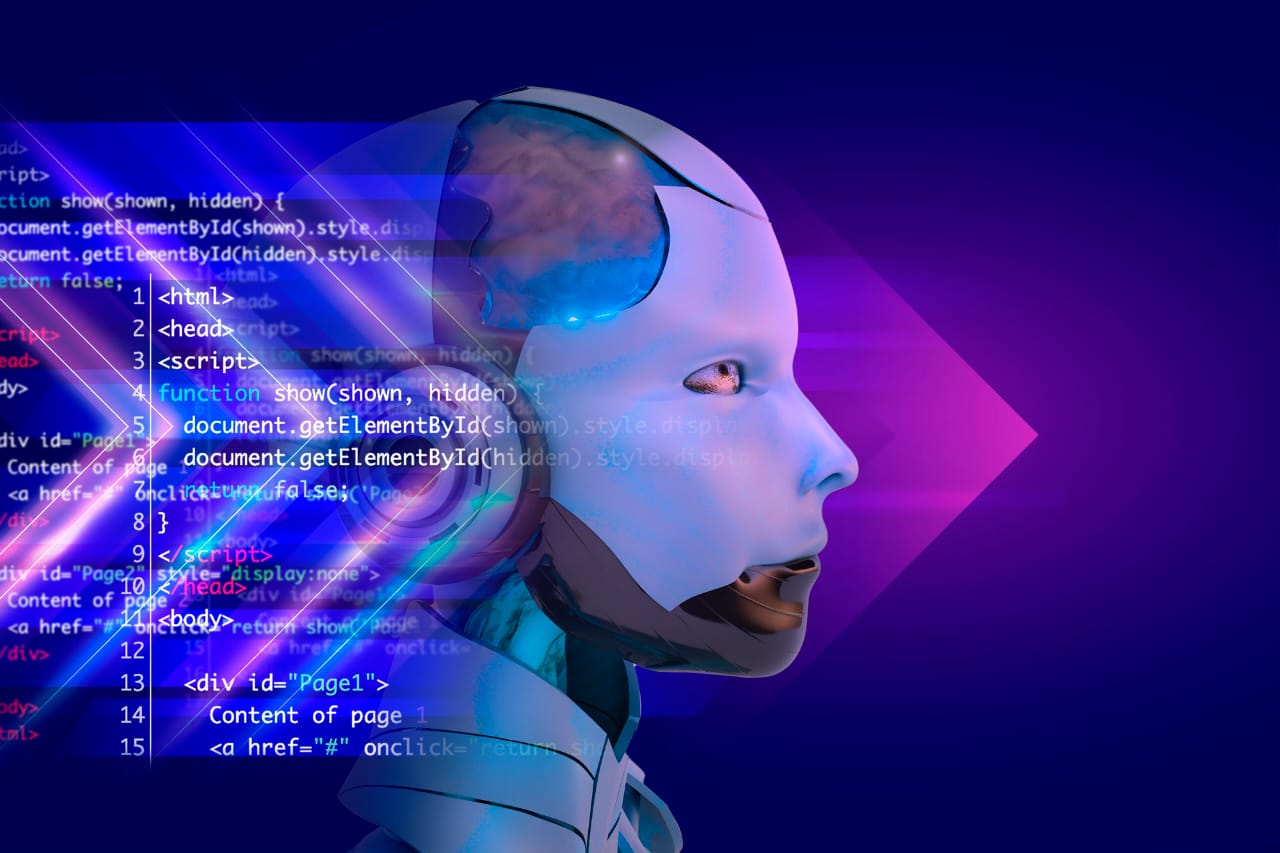Artificial Intelligence (AI) is defined as the intelligence displayed by an artificial unit to solve complex problems and such a system is usually a computer or machine is believed. Artificial intelligence is the integration of computer science and physiology. Artificial Intelligence (AI in simple language is the computational part of the ability to achieve goals in the world. Intelligence is the ability to imagine, remember and understand, recognize patterns, make choices consistent with change, and learn from experience. Artificial Intelligence (AI) is concerned with making computers behave more humanly like humans in fashion and in a much shorter period of time than humans. Hence it is called Artificial Intelligence.। According to AI’s philosophy, artificial intelligence can be divided into parts A) strong AI b) weak AI.
Strong AI
The principle behind empowered AI is that machines can be made to think or in other words represent the human mind in the future. Thus Strong AI claims that in the near future we will be surrounded by machines that can function completely like humans and the machine has human level intelligence Can. If so, those machines will have the ability to reason, think and do all the work that a human being is capable of doing. Current research is nowhere close to creating strong AI, and there is a lively debate on whether this is possible as well.
Weak AI
The principle behind weak Artificial Intelligence (AI) is simply the fact that machines can be made to act as if they are intelligent. Weak AI simply states that features such as thinking can be easily added to computers to make them more useful tools and it already starts happening has gone. For example, when a human player plays chess against a computer, the human player may feel as if the computer is playing really impressive tricks. But the application of chess is not thinking and planning at all. All the work done by this is already fed into the computer by a human and thus it is ensured that the software will do the right things at the right time. More examples of weak AI are witness specialist systems, starry cars and speech recognition systems. Artificial intelligence (abbreviated as AI) is the ability of a device to perform activities that would otherwise be expected only from the human brain. These activities include the ability to have knowledge and the ability to acquire it. It also includes the ability to test relationships, understand, and ultimately generate fundamental ideas.
Turing testing is a test of a machine’s ability to demonstrate intelligent behavior. The trial was initiated by Alan Turing in his 1950 paper computing machinery and intelligence. The original and main question behind this test was “Can Machines Think?” “. The trial thus proceeds that a human judge interacts in natural language with a human and a machine, each of which tries to look human. All participants are placed in separate locations. If the judge cannot reliably tell the machine to a human, it is said that the machine has passed the test. To test the Intelligence of a machine rather than the ability to present words in audio, the interaction is limited to text channels such as computer keyboards and screens only. Many interrogators are unable to separate the computer from the human being, so it can be concluded that the computer thinks.
Advantages and Disadvantages of Artificial Intelligence
1. A major advantages of artificial intelligence is that its decisions are based on facts rather than emotions. Even after our extreme efforts, it is a well-known fact that human decisions are always negatively affected by our feelings.
2. Unlike humans, machines with artificial intelligence do not require sleep, thereby overcoming the inherent loss of fatigue in humans.
3. Easy dissemination of knowledge. Once an artificial mind is trained for something, it can be copied to others very easily, Which reduces the time wasted in imparting knowledge to other humans through training.
4. Lack of creativity in reactions.
5. Inability to explain the logic and reasoning behind a certain decision.
6. Current development is at a level where AI cannot know that there is no solution to a particular problem.
7. AI can produce the wrong solution due to any malfunction and since it cannot clarify the logic behind its answer, Blind dependence on AI can cause problems.
8. Lack of common sense in reasoning can also cause major problems.
9. When given in the wrong hands, it can be used to cause mass destruction.
All this being said, the most worrying problem with the development of AI is that it will soon start replacing humans in every field, This will lead to higher rates of unemployment, leading to depression, crime and poverty. In addition, there are some areas that require human touch and there is growing belief that machines will likely never replace humans. The caring behavior of nurses in hospitals is an example of the work with which humans feel that machines will never be able to do justice.
Current Progress of Artificial Intelligence
Artificial Intelligence (AI) was created with the sole purpose of imitating or outperforming the human brain. So it is very important that we question the fact whether he is really capable of doing this.
One cannot ignore the fact that AI is being used all around us, especially in fields like medicine, robotics, law, stock trading, etc. It is being used in homes and large establishments. Like military bases and NASA space stations. NASA has sent artificially intelligent robots to planets to learn more about their habitats and environments, to find out if there is a possibility for humans to live on these planets. Mercedes-Benz and other auto manufacturers, Washington, D.C. Expert systems have been used in the design of vehicle components. Subway systems use specialist system software controllers to stop subway trains to within 3 inches of the correct location on the platform. These trains are mainly manned by motormen to reassure the passengers.
AI has become incorporated into common applications in these areas and has become so common that it is no longer referred to as Artificial Intelligence. Blind proponents of AI will point to the time when AI Deep Blue II defeated chess master Garry Kasparov, proving that artificial intelligence can indeed be smarter than humans. Although there’s no doubt that the AI Deep Blue II won that game, it’s still probably one of the dumbest software out there. Operators were programming the AI in each round based on the opponent’s last move. Furthermore, Deep Blue II studied all of Kasparov’s previous games, while not giving the latter as much advantage. One can safely say that even though Deep Blue II Artificial Intelligence defeated Kasparov, it was never a fair fight to begin with.
The latest technologies like Xbox 360’s Kinect and iPhone’s Siri use algorithms based on artificial intelligence, but it is a well-known fact that these technologies are far from perfect. Thus we can safely conclude that although Artificial Intelligence has made considerable progress over the past few decades, it is not at a level where one can confidently say that it is now capable of completely replacing the human brain. is ready. That being said, there is now a large amount of research being conducted in the area of proper simulation of the human brain. Cortex Artificial Development Inc. and the Swiss government’s IBM-sponsored Blue Brain Project, which are two main ventures aimed at simulating the human brain.
Applications of Artificial Intelligence
The application of Artificial Intelligence (AI as neural networks and specialist systems occurs in almost all human activities. The combination of high precision and low computation time makes AI a state-of-the-art technology. Robot ES is already taking workshop level jobs in large industries, thus bringing humans into a more supervisory role. Stock brokerage firms are now using Artificial Intelligence to analyze data, analyze and buy or sell stock without any human intervention. Some applications of Artificial Intelligence are:
A. Gaming industry
One of the most common known applications of AI in the gaming industry is its use in chess। Even though these machines are not as intelligent as humans, Nevertheless they use brute force algorithms and scan 100 positions every second to determine the next move. AI is also being used in the Microsoft Xbox 360’s Kinect to detect body motion, as previously stated. But it is still in its infancy and requires much advancement to be used in everyday applications.
B. Heavy industry
Artificial intelligence robots have become very common in heavy industries and are employed in jobs that are otherwise considered dangerous to humans. These robots also increase efficiency, as they do not require a break while working, eliminating the inherent loss of fatigue in humans.
C. Weather forecast
Neural networks are being used nowadays to predict weather conditions. Previous data is provided to neural networks, which analyze data for patterns and predict future weather conditions.
D. Expert systems
Expert systems are machines that are trained to have full expertise in specific areas of interest. These have been developed to solve the problems of specific areas. These systems use statistical analysis and data mining to solve these problems by extracting solutions through a logical flow of yes-no questions. An expert system is made up of 3 parts – knowledge base – all those information, rules, Stores data and relationships that the expert system needs to have total expertise in its area of interest. Estimation Engine – This information demands a question to be submitted But from the basis of knowledge, Analyzes it and reacts with a solution or recommendation in the same way as a human expert rule – it is a conditional statement that connects the given terms to the final solution.
E. Data Mining or Knowledge Extraction
Data mining is a rapidly evolving field। Data mining is a part of a process called KDD knowledge search in databases. This process basically involves steps that are taken before data mining such as data selection, data cleaning, pre-processing of data, and data transformation. “Data mining is the use of computer algorithms to discover hidden patterns and unexpected relationships between elements in a large data set. AI is a wider field than machine learning. AI systems are knowledge processing systems. Estimation and control, including knowledge representation, knowledge acquisition, and discovery, are three basic techniques in AI.
F. Knowledge Representation
Data mining seeks to discover interesting patterns from large amounts of data. These many types of patterns can take various forms, such as association rules, classification rules and decision trees, and therefore, knowledge representation becomes an issue of interest in data mining.
Future aspects of Artificial Intelligence
The use of Artificial Intelligence (AI) will create machines and computers that are much more advanced than what we have today. Speech detection systems will reach higher levels of performance and will be able to communicate with humans using both text and voice in unstructured English. Someday all aspects of health care, both clinical and administrative, will improve patient care and financial, social and other resources allocation experts will have a great future for system applications. But when it comes to creating machines more intelligent than humans through artificial intelligence, no one seems to have the answer. Also, if it is possible then how much time it will take cannot be estimated. It is also expected to have characteristics of the human brain such as learning from experience, cognition and perception. It is still not known whether these machines will include human consciousness or not. In the future, robots will be able to do everyone’s work and will be faster and more efficient in doing it than humans. If someone is ill, they can hire a robot nurse who will provide them with medicines at appropriate intervals. Thus it can be safely said that Artificial Intelligence is still in its embryonic stage and its future depends only on scientists solving the mystery of the human brain. Until this happens, no one can conclude whether our future will be positively or negatively affected by Artificial Intelligence.
The computing world has a lot to gain or benefit from various AI approaches. For example, the ability of artificial intelligence to learn makes them very flexible and powerful. Also, there is no need to prepare an algorithm to perform a specific task, that is, there is no need to understand the internal mechanism of that task. They are also very suitable for real-time systems due to their fast response and computational time due to their parallel architecture. The goal of artificial intelligence is to create computers whose intelligence is equal to or greater than that of humans. To achieve this goal is the famous “AI problem” of the last decade, researchers are trying to bridge the gap between human intelligence and artificial intelligence.
Read Also:
- Artificial Intelligence in Internet Services
- Artificial Intelligence (AI) and The Future of The Internet
- Artificial Intelligence (AI) in Smart Homes
- Difference Between Machine Learning and Artificial Intelligence








Leave a Reply